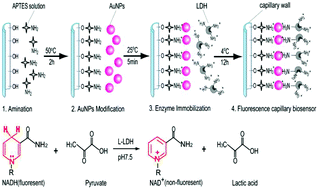Development of a fluorescent capillary biosensor based on self-assembled AuNP/LDH for micro-volume intracellular pyruvate†
Abstract
Herein, a fluorescent capillary biosensor was developed for quantifying micro-volume intracellular pyruvate (PA), in which AuNPs and lactate dehydrogenase (LDH) were modified on the inner surface of an amination capillary (20 μL) via a self-assembly technique. The PA concentration was quantified by the change in the value of the fluorescence of NADH after sucking a mixed solution of the sample and NADH into the biosensor. This study investigated factors including the degree of protonation of the amino groups on the surface of the capillary, the AuNP concentration and time for self-assembly, the activity concentration and time for the LDH self-assembly, the flow rate and acidity for LDH immobilization, pH, temperature, and reaction time for the NADH/PA/LDH reaction system. Under the optimized conditions, the linear response range of the biosensor towards PA was 2.5–120 μmol L−1, in which the determination limit and detection limit were 2.5 and 0.75 μmol L−1, respectively. The biosensor could be reused more than 41 times when its relative standard deviation (RSD) was controlled at less than 1.5%. At room temperature (approximately 25 °C), the intracellular PA in the erythrocyte of a healthy person was measured using the biosensor, and the PA content was observed to be 241.76 ± 68.05 μmol L−1 (n = 8). The standard addition recovery was 95–106%. Employment of the AuNPs in the PA biosensor not only improved the affinity of the immobilized LDH towards PA and its stability, but also significantly enhanced the service life of the PA biosensor.



 Please wait while we load your content...
Please wait while we load your content...